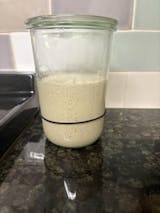How to care for your new Sourdough Starter? (Guide for GetSourdough Customers)

This article is specifically written if you are buying a sourdough starter from GetSourdough. This is a short guide on how to look after your new sourdough starter, in the next 48 hours and then hopefully forever.
If you aren't buying a sourdough starter from GetSourdough you can still use the ratios we suggest but be aware that your sourdough might be used to a different regiment.
Your sourdough starter is shipped at 40% hydration (this means for every 100gr of flour there is 40gr of water), it also includes your first feed in the jar (that’s the dry flour you see).
We generally recommend you stick to the flour that your sourdough starter is made of when feeding:
The Original Sourdough Starter: Strong Wheat Flour
The Spelt Sourdough Starter: Wholewheat Spelt Flour
The Rye Sourdough Starter: Dark (Wholewheat) Rye Flour
The Gluten Free Starter: Buckwheat flour (or a blended gluten free flour).
First 10 minutes after unpacking:
Do you want to bake in the next 24 hours? If yes, follow these instructions:
Most recipe call for 100% hydration of sourdough starter, the instructions below achieve this. This is a pancake batter consistency for reference.
- Add 60gr of room temperature filtered or bottled water. (Tap water contains chlorine which will kill some of the wild yeast and good bacteria present).
- Mix well all the dry flour, sticky starter (already in the jar) and water you added.
- Leave out on your counter until the starter doubles in size. (4-12 hours)
- After you take out what is needed for your recipe, feed the leftovers with 1 part flour and 2 parts water (minimum 25gr flour and 50gr water recommended).
- Place in fridge and use the ‘Regular Feeding’ method below, from now on.
If you don’t want to bake in the next 24 hours:
This keeps your starter at 50% hydration, which is our recommended hydration for storing in the fridge. This is bread dough consistency with wheat flour and very thick batter consistency with rye or spelt flours.
- Add 30gr of room temperature filtered or bottled water. (Tap water contains chlorine which will want to kill some of the wild yeast and good bacteria present).
- Mix well all the dry flour, sticky starter (already in the jar) and water you added.
- Place in the back of the fridge until you are ready to bake or it needs a regular feed.
48 hours+ after receiving your starter:
Regular Feeding:
You can keep your starter strong, but feed it slightly less often, if you use a 50% hydration ratio. We recommend feeding your main starter every 3-4 days.
- Get your starter from the fridge
- Discard about 20% of your starter (you can feed this for the next bake or use it in recipes like crumpets or pancakes).
- Feed your starter 2 parts flour and 1 part filtered water. (Minumum of 50gr of flour and 25gr of water recommended per feed).
- Mix well and place back in the fridge.
When you are ready to bake (12 hours before):
- Check your recipe for how much starter you need (example 200gr)
- Take out 2 parts (40gr of starter) out of the main starter jar into another container
- Add 4 parts (80gr flour) and 4 parts (80gr) of filtered water to the 40gr of starter
- Mix well and leave on the counter for 12 hours (do this the night before baking).
- Your starter should have doubled in volume before you bake. If that is not the case, discard 20% of your starter and feed again with 4 parts flour and 4 parts water.





